Does'nt the onus rest with you to provide some verification, having made the claim? (ALERT: rhetorical question.)I'm sure there is...
Frank
In and of itself, I agree THD's not very useful. However, THD is a special case of n tone IMD where all n tones fall at the same frequency and hence THD levels usually correlate well with IMD levels---after all, they're just different ways of measuring the same nonlinearities. Since the metrics which agree well with subjective preferences all seem to be IMD based one often ends up using THD as a proxy for IMD and then dumping the proxy into an IMD metric. In my experience that approach usually has decent predictive power.the distortions we see published may have little relevance to sonics (THD being one)
Hmm, thinking about it a bit I guess that conclusion does follow logically from the first statement.I won't (and don't have time to) go through that 90 pages of paper, though. I don't think that paper can explain why tube and sand sound different, and why I like tube more.
Last edited:
Does'nt the onus rest with you to provide some verification, having made the claim? (ALERT: rhetorical question.)
I don't need to prove anything.
dave
In and of itself, I agree THD's not very useful. However, THD is a special case of n tone IMD where all n tones fall at the same frequency and hence THD levels usually correlate well with IMD levels---after all, they're just different ways of measuring the same nonlinearities. Since the metrics which agree well with subjective preferences all seem to be IMD based one often ends up using THD as a proxy for IMD and then dumping the proxy into an IMD metric. In my experience that approach usually has decent predictive power.
True. Still leaves a lot on the table.
dave
Yep. But I think there's enough of a framework there to formulate some hypothesis, test them, and see where it goes. And unless we, as a community, step outside of the usual circlar discussion about THD and masking we're unlikely to improve our collective understanding. In particular, reduced tall order distortion tends to lower IMD floors since each part of the input PSD is spread over a narrower bandwidth.Still leaves a lot on the table.
However, I'm not aware of any data which disambiguates between lower tall order and a lower IMD floor and lower tall order with the same IMD floor. That'd be a nice one to pin down but I'm not immediately seeing a good way to do a controlled test. Maybe by varying the excess loop gain available within a composite amp?
Apparently not, you are free to make a statement (outlandish as it may be) then walk away. Why do standards differ for you?I don't need to prove anything.
Frank
... are the compression drivers in your system active or passive cross?
Now my system is 2way active and overal 3way -- low / mid-high, plus an active sub. (so it's actually 3.5way, whatever... )
Mid / high is passively xover'ed (low Q 2nd order) and driven by a tube amp (2A3 SE) which sees line level signal above 240Hz. That's done by 1st order line level passive filter before pre amp, which is also tube (5842/417A with OPT).
LF channel is driven by a chip amp (3886), and the upstream is 1st order line level passive filter set to 50Hz or so (IIRC, to compensate OB loss).
Active sub is driven by SS plate amp with built-in 2nd order line level filter (set to 40Hz LP, it's lowest point available).
This system has been 'evolving' for 15 years. The 'backbone' is the 2way active / overal 3way structure. The amps I've used are gradually changed from SS to tube. In a period, they were all tubes. I even used 300BSE for bass channels (not excellent, but it can do pretty good).
One of the best bass I've heard is driven by tube amp, not mine, though. Pity.
Now I use SS (chip) amp for bass mainly because I can play with the feedback circuit to get high output impedance I need (for compensating the low Q woofers on OB). SS amps have higher voltage gain so I can fiddle with it more freely than tubes. For bass, SS is indeed easier to get right.
Yep. But I think there's enough of a framework there to formulate some hypothesis, test them, and see where it goes. And unless we, as a community, step outside of the usual circlar discussion about THD and masking we're unlikely to improve our collective understanding. In particular, reduced tall order distortion tends to lower IMD floors since each part of the input PSD is spread over a narrower bandwidth.
However, I'm not aware of any data which disambiguates between lower tall order and a lower IMD floor and lower tall order with the same IMD floor. That'd be a nice one to pin down but I'm not immediately seeing a good way to do a controlled test. Maybe by varying the excess loop gain available within a composite amp?
Because it is a lot of work to search for what our ears are sensitive for and adapting our system to it. What would be cost effective.
So it is also possible to do it the other way around.
Use a amp that goes up HF and LF so the cut of ad low and high doesn't distort the spl level and phase within 25-18kHz. With perfect voltage gain and very low output impedance.
DR Geddes came to the conclusion that THD IMD at low levels are really bad, at high level very difficult to hear even levels up to 25%!
So the amp has to have very low thd at levels <1W. That is 1-0 for people who love class A tube amp. (The tube amp output voltage is heavily influenced by the speaker impedance. Try to make a loudspeaker that behaves like a resistorload then you know how it really sounds).
I aspect to find a lot of faulty behaviour of amps with a speaker as load. Only this is seldom seen in measurements because it is tested with a resistor load.
What I am saying is loudspeaker and amplifier interact, heavily with tube amp little with a good analogue and very little with a good class-D.
Last edited:
Frank you are being harsh there, what Dave says is true, it is why we often see a snake not a stick when looking into shadows, because those who see a stick are more likely to be bitten by a snake.
The evidence is largely anecdotal but it is there.
This isn't about "Golden Ears" either, it is just a natural part of the human condition, like being able to hear a baby cry or a child scream.
Those who look in shadows ? listen to the wind?? and see/hear tigers are those who live to breed!
Sorry I cant point you to the documentation but I have read some of it at various times
The evidence is largely anecdotal but it is there.
This isn't about "Golden Ears" either, it is just a natural part of the human condition, like being able to hear a baby cry or a child scream.
Those who look in shadows ? listen to the wind?? and see/hear tigers are those who live to breed!
Sorry I cant point you to the documentation but I have read some of it at various times
Curious to hear your subjective impressions of tube versus sand on the mid and high.my system is 2way active and overal 3way
Maybe. As you've observed, it's not often measured. And half the time I bring up such end to end testing I get a reaction like I have eyestalks.What I am saying is loudspeaker and amplifier interact, heavily with tube amp little with a good analogue and very little with a good class-D.
Hmm, I may have an opportunity to do A/B measurements on some KRK R6s with four different sand amps and two tube amps coming up...
I might share some, hopefully not too much...
My first 'pre amp' is OP based buffer - BUF03. It was OK, not so great as that magazine said. (Well, I was young and didn't know much.) I even built a 2nd one with 'luxury' version of power supply - 2 stages of voltage regulators for each chip. And there were 2 chips per channel - one in front of the volume pot, one after. It was not any better than the first simple one. Again, I was young then.
The 3rd was Bride of Zen. It was better. I like its richness and warmth (related to the chip above). It got warmer when biased deeper. I made it 40mA IIRC.
And then, I built the tube pre amp I'm using now. 4-ch 417A/5842 with Lundahl OPT (or they call it 'interstage trafo'), 2ch for mid/high, 2ch for bass. I put the line level passive xover in front of them. The differece between this and BOZ is larger than that between BOZ and BUF03. The lifelike, flesh-like warmth and richness are all retained, with clearer details and more open overall presentation.
Similar impressions also apply to power amps. Very often, it's said that tube sound is more 'romantic', slow and easy, layback, dim, foggy... etc., or that kind of 'old' atmosphere, but what I hear is not. Tube amps I've heard are usually very clear and detailed. They give me a feeling of diving in clean water, in which I can feel the liquid around me and can see everything underwater clearly; or in a country side with clear weather in which I can breathe the fresh air and see very far...
Of couse my own experience is very limited. Maybe I turned to tubes in quite early stage of my audio life, so I get involved more with them. I do know there are some very high quality SS amps out there, but they tend to be very large and heavy, the most important - very expensive. And they are also very complex to build - out of my very limited DIY capability. So, inevitably I turned to "simpler" tube amps.
Recent new experience was a T-amp (Amp 6 by 41Hz). It has very good reputations on the web. It works very good with my fullrangers in a series of experiments. It has a sharpened and highly focused quality in its sound. Very suitable for the 8" fullrangers I own and modded (whizzer chopped). The combination sounded clean, jumpy, and very energetic, thus a sense of very powerful. (so they call it a small amp with big sounds)
However it's not so successful in my main system. The sensitivity of the mid-high (horn) section is very high, over 105dB/w, so it's very revealing to all kinds of noise. Amp 6 has quite a bit of hiss I can't get rid of, although it might not be the major problem. The real drawback, in this combination, is the "edginess" in the sound. The aforementioned "clean, jumpy, and very energetic" sound is overdone here. There seem a black line of contour around everything on the stage - an overemphasized imaging and detail. (the line is very thin, though).
The textures and overtones of the real things tend to be a continuous distributions in a quite large range, instead of a clean cut boudary. I'm not saying there's no texture in this amp, it's the proportion and distribution don't sound right to me. At that time, I use 0.7W 6S45 spud amp, which sounded more natural, with same degree of detail revealing ability but without the overemphasis.
One can argue with that by the POV of frequency response. Tuning the top end somewhat may largely affect the detailing mentioned above. I'd agree on that to some extent, and I did try some EQ on them in the comparison, too. But eventually I still found they are different, in a deeper and more intrinic layer I can't explain.
After 6S45, I'm using 2A3 now. It shows more weight and power. It seems each stroke on the instrument is slightly deeper and harder when called for. This make it more persuasive and touching in music. For this amp, I modded the pre to have very high gain (to be a driver). This 'abnormal' gain structure makes swapping and comparing power amps more difficult, so I haven't done that since. And probably won't in the foreseeable future.
Oh, it's already too much. Just my 2c.
My first 'pre amp' is OP based buffer - BUF03. It was OK, not so great as that magazine said. (Well, I was young and didn't know much.) I even built a 2nd one with 'luxury' version of power supply - 2 stages of voltage regulators for each chip. And there were 2 chips per channel - one in front of the volume pot, one after. It was not any better than the first simple one. Again, I was young then.
The 3rd was Bride of Zen. It was better. I like its richness and warmth (related to the chip above). It got warmer when biased deeper. I made it 40mA IIRC.
And then, I built the tube pre amp I'm using now. 4-ch 417A/5842 with Lundahl OPT (or they call it 'interstage trafo'), 2ch for mid/high, 2ch for bass. I put the line level passive xover in front of them. The differece between this and BOZ is larger than that between BOZ and BUF03. The lifelike, flesh-like warmth and richness are all retained, with clearer details and more open overall presentation.
Similar impressions also apply to power amps. Very often, it's said that tube sound is more 'romantic', slow and easy, layback, dim, foggy... etc., or that kind of 'old' atmosphere, but what I hear is not. Tube amps I've heard are usually very clear and detailed. They give me a feeling of diving in clean water, in which I can feel the liquid around me and can see everything underwater clearly; or in a country side with clear weather in which I can breathe the fresh air and see very far...
Of couse my own experience is very limited. Maybe I turned to tubes in quite early stage of my audio life, so I get involved more with them. I do know there are some very high quality SS amps out there, but they tend to be very large and heavy, the most important - very expensive. And they are also very complex to build - out of my very limited DIY capability. So, inevitably I turned to "simpler" tube amps.
Recent new experience was a T-amp (Amp 6 by 41Hz). It has very good reputations on the web. It works very good with my fullrangers in a series of experiments. It has a sharpened and highly focused quality in its sound. Very suitable for the 8" fullrangers I own and modded (whizzer chopped). The combination sounded clean, jumpy, and very energetic, thus a sense of very powerful. (so they call it a small amp with big sounds)
However it's not so successful in my main system. The sensitivity of the mid-high (horn) section is very high, over 105dB/w, so it's very revealing to all kinds of noise. Amp 6 has quite a bit of hiss I can't get rid of, although it might not be the major problem. The real drawback, in this combination, is the "edginess" in the sound. The aforementioned "clean, jumpy, and very energetic" sound is overdone here. There seem a black line of contour around everything on the stage - an overemphasized imaging and detail. (the line is very thin, though).
The textures and overtones of the real things tend to be a continuous distributions in a quite large range, instead of a clean cut boudary. I'm not saying there's no texture in this amp, it's the proportion and distribution don't sound right to me. At that time, I use 0.7W 6S45 spud amp, which sounded more natural, with same degree of detail revealing ability but without the overemphasis.
One can argue with that by the POV of frequency response. Tuning the top end somewhat may largely affect the detailing mentioned above. I'd agree on that to some extent, and I did try some EQ on them in the comparison, too. But eventually I still found they are different, in a deeper and more intrinic layer I can't explain.
After 6S45, I'm using 2A3 now. It shows more weight and power. It seems each stroke on the instrument is slightly deeper and harder when called for. This make it more persuasive and touching in music. For this amp, I modded the pre to have very high gain (to be a driver). This 'abnormal' gain structure makes swapping and comparing power amps more difficult, so I haven't done that since. And probably won't in the foreseeable future.
Oh, it's already too much. Just my 2c.
Thanx Moondog,
It is hard to Google for this a lot of extraneous hits, but here is a start.
The Cocktail Party Effect on ADVANCE for Hearing Practice Management
Now go back to when your Great x many grandparents were skulking on the savanah and think about what kind of hearing was needed to not be "kitty" food. Now extrapolate forward and think about how much annoying & unnatural things like high order distortion products & notch distortion are going to stick out as a threat.
dave
It is hard to Google for this a lot of extraneous hits, but here is a start.
The Cocktail Party Effect on ADVANCE for Hearing Practice Management
Now go back to when your Great x many grandparents were skulking on the savanah and think about what kind of hearing was needed to not be "kitty" food. Now extrapolate forward and think about how much annoying & unnatural things like high order distortion products & notch distortion are going to stick out as a threat.
dave
Speaker vs. Amplifier
I work with designing speaker and I have done that for over 20 years.
I will say that amplifier is near to important as speaker, yes speaker is more easy to hear difference in short time, but in the long run. Amplifier is some time more important. Because the amplifier is what drive this tricky load that speaker are.
Digital Amplifier! I have not heard one that sounds good as analogue, yet. The day will come, but I have not seen it yet.
Best is amplifier from ABLETEC, hypex is ok, ICE Power you can use for Life style thing or other. The problem with these Digital designer guys is that they come from power supply. They count power and load, and than they design after this. Like the early days. 20W amplifier 8 Ohm load, than you need 1,6 A current capability. If you say so now in an analogue amplifier design, then they ask you what planet are you from or were have you been the last 40 years.
I did some simple measurement years ago, small speaker 6”, small amplifier <50W. One the scope I measured 8A peak current on music with a load of 4 Ohm =256W !!
We need more power= current than we think. And than look for the Power capacitors in some digital amplifier and compare with analogue design. This is not the hole true but part of it.
+10
Agree , never heard one that sounded natural or acceptable .....
I build loudspeakers because I can.
I build tube amps because I can.
I build a lot of things because I can ... and because I'm cheap.
LOL.....
to show the difference between an analogue amp and a switching one.
A quality briston amp
thd -power
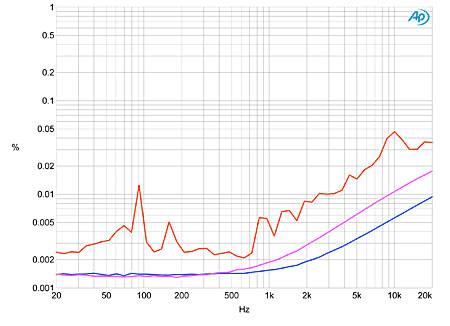
Bryston 7B SST2, THD+N (%) vs frequency at 14V into: 8 ohms (blue), 4 ohms (magenta), 2 ohms (red).
output -load. With our simulated loudspeaker, the variations in response remained within ±0.1dB limits
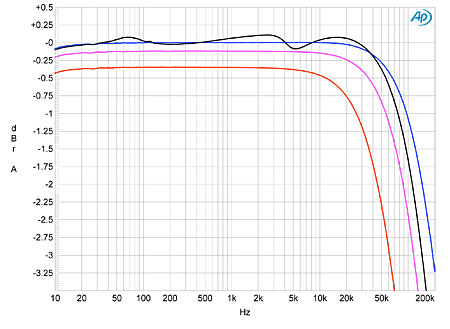
another solidstate amp.
Paravicini M100A, 4 ohm tap, THD+noise (%) vs frequency at (from top to bottom at 5kHz): 2.83V into simulated loudspeaker load, 4W into 2 ohms, 2W into 4 ohms, 1W into 8 ohms, 0.5W into 16 ohms.
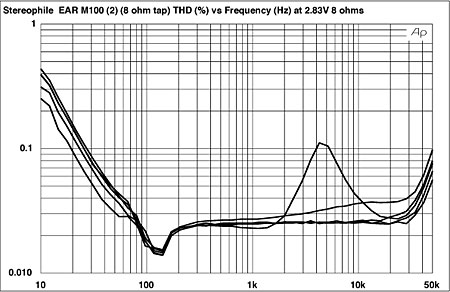
Paravicini M100A, 8 ohm tap, frequency response at (from top to bottom at 2kHz): 2.83V into dummy loudspeaker load, 1W into 8 ohms, 2W into 4 ohms, 4W into 2 ohms (0.5dB/vertical div.).
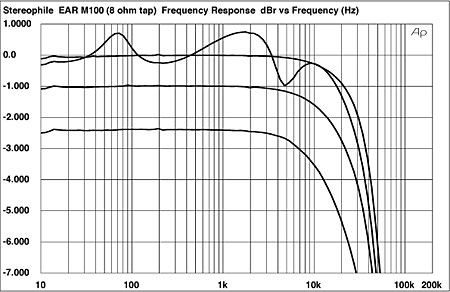
compare with a kt66 tube amp.
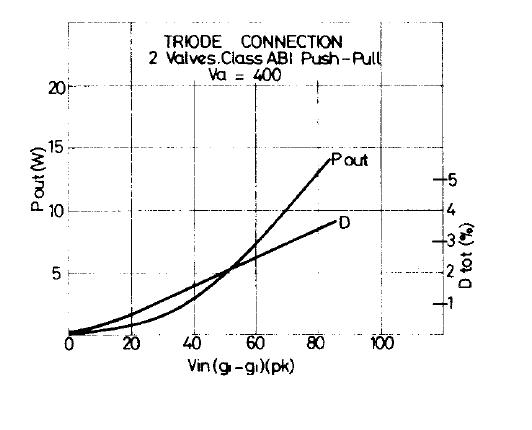
and at last a switching amp. class d
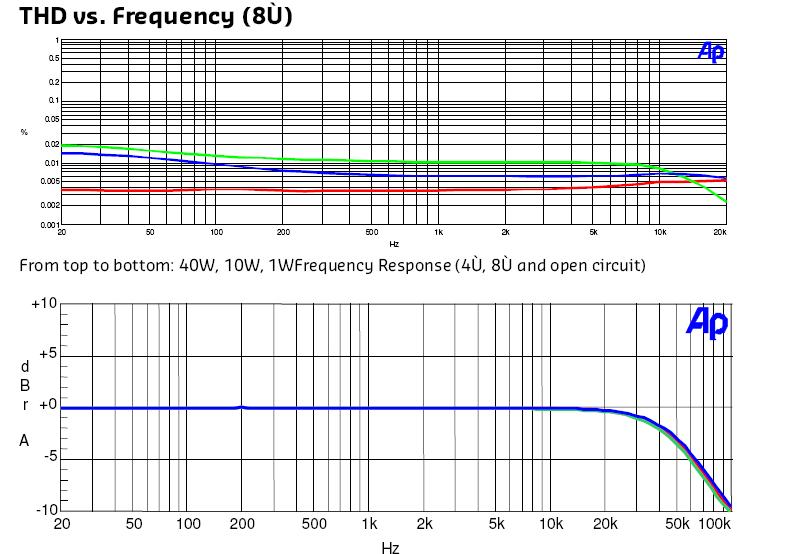
So what I want to make clear, difference we can hear sure. Caused by load depended behaivour of the amplifier.
So to be sure the amp doesn't mess with the recording I want a amp that delivers enough current without dropping in output voltage. So I need a powerfull power-supply and end-stage. Or a loudspeaker with flat impedance correct 8 ohm load.
Interesting was the class D on simulated load ?
Hypex I presume?
No wonder the top end is "dull".....
Seriously: Good class-D is the thing for me, it sounds just "right", with very little sonic artefacts. And yes, I do own other amps, even a Audio Note tube amp. But they just dont sound right.
I have found them to be the opposite, you would have to have a pretty "soft" sounding speaker for Class-D top end to sound "right"...
well , Just saying ..................
And haven't we read many times that scientific studies have found anecdotal evidence to be among the most unreliable though seemingly plausible and able to be believed. Relating current technology sound reproduction to an imagined primeval past is pushing the envelope just a bit.Frank you are being harsh there, what Dave says is true, it is why we often see a snake not a stick when looking into shadows, because those who see a stick are more likely to be bitten by a snake.
The evidence is largely anecdotal but it is there.
This isn't about "Golden Ears" either, it is just a natural part of the human condition, like being able to hear a baby cry or a child scream.
Those who look in shadows ? listen to the wind?? and see/hear tigers are those who live to breed!
Sorry I cant point you to the documentation but I have read some of it at various times
Are you serious? I don't have any personal recollection of what it was like before I was born and not for a few years after that. This is very fanciful and, utterly, nonsensical conjecture.It is hard to Google for this a lot of extraneous hits, but here is a start.
The Cocktail Party Effect on ADVANCE for Hearing Practice Management
Now go back to when your Great x many grandparents were skulking on the savanah and think about what kind of hearing was needed to not be "kitty" food. Now extrapolate forward and think about how much annoying & unnatural things like high order distortion products & notch distortion are going to stick out as a threat.
Frank
Interesting was the class D on simulated load ?
No, it is hard to put 40W in a virtual load
Sander Sassen hardware analyses did the test.
Here the data sheet of the 400W amp. The lowest thd at 500mW perfect in the area where we normaly listen music.
http://www.hypex.nl/docs/UcD400HG_datasheet.pdf
With my horn witch goes up to 30Khz it has extreme low thd (at 105dB around -57dB second and around -80dB third harmonic!). It sounds warm with detailed high tone's but not as fine pin pointing as the vintage VFET amp.I have found them to be the opposite, you would have to have a pretty "soft" sounding speaker for Class-D top end to sound "right"...
well , Just saying .......
Attachments
Last edited:
Maybe. As you've observed, it's not often measured. And half the time I bring up such end to end testing I get a reaction like I have eyestalks.In such cases almost any data's useful, so it's just a matter of grabbing some and seeing what it says. Certainly I've had to shift tweeter EQ by a dB or two switching between solid state amps with different GBPs.
Hmm, I may have an opportunity to do A/B measurements on some KRK R6s with four different sand amps and two tube amps coming up...
I posted my stereo room response several times and people say they cant do anything with the wobbly results.
typical persons how never thought about what they actual hear on their listening position. And like to see a flat plot like in the brochure.
Horn almighty measured at listening position.http://www.diyaudio.com/forums/multi-way/170024-project-presentation-horn-almighty.html
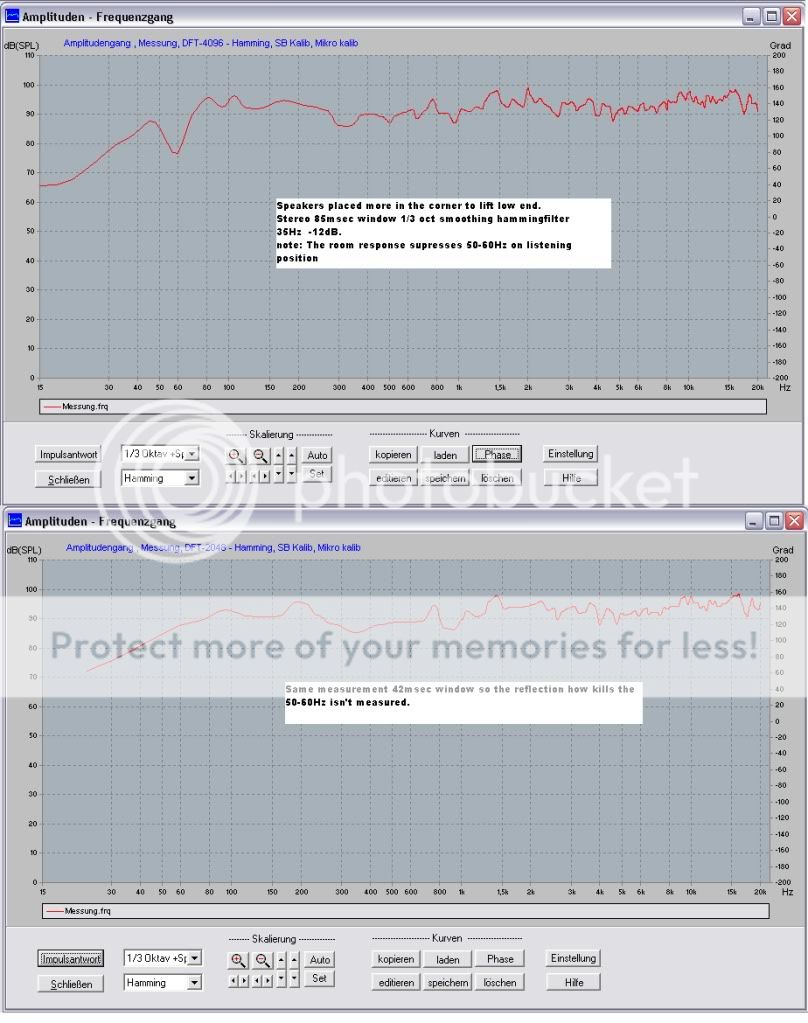
Stereo magnepans on class d amp smooth response lifting low and high like a loudness curve.
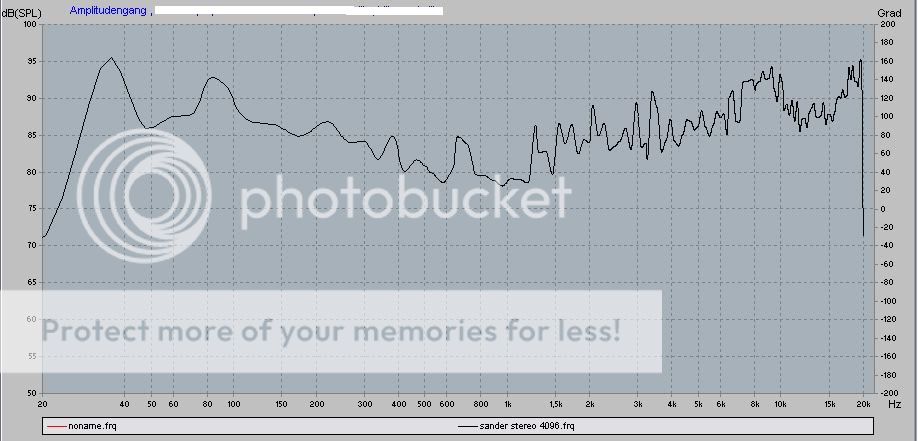
Stereo Dáppolito I build for my colleague.http://www.diyaudio.com/forums/multi-way/130857-high-end-3-way-dappolito-aluminiumcone.html
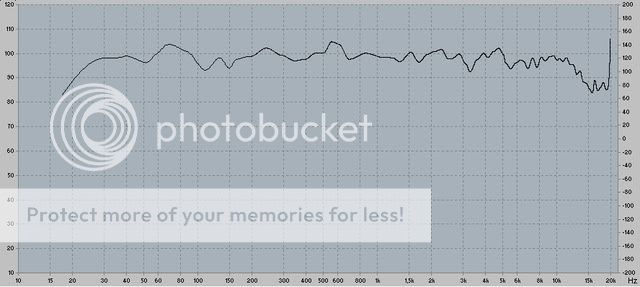
stereo response fatboy project.http://www.diyaudio.com/forums/multi-way/137036-big-bandpass-fatboy.html
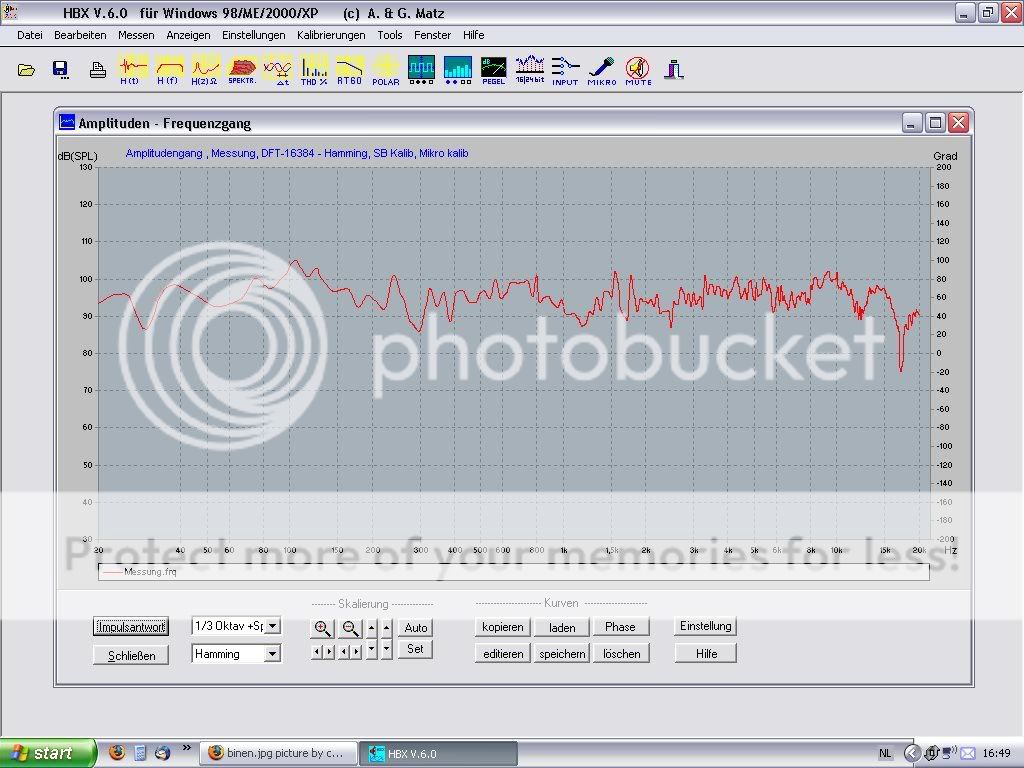
Last edited:
And haven't we read many times that scientific studies have found anecdotal evidence to be among the most unreliable though seemingly plausible and able to be believed. Relating current technology sound reproduction to an imagined primeval past is pushing the envelope just a bit.
Are you serious? I don't have any personal recollection of what it was like before I was born and not for a few years after that. This is very fanciful and, utterly, nonsensical conjecture.
Frank
It's hardly worth getting worked up over, I'm sure there is some truth in what Planet10 is saying, life's too short to be taking things so seriously. This is suppose to be about having fun and sharing thoughts & ideas
Thank you for your concern, DQ, but I don't think I was "getting worked up". I asked a simple question and, if there is some truth, wanted some evidence to justify such a statement. Thanks also for your platitudes but I think they might be better served on someone else, maybe P10, for example.It's hardly worth getting worked up over, I'm sure there is some truth in what Planet10 is saying, life's too short to be taking things so seriously. This is suppose to be about having fun and sharing thoughts & ideas
Frank
My speakers have metal cone mids and woofers, and AMT tweeter. Not what I consider "soft" sounding.....I have found them to be the opposite, you would have to have a pretty "soft" sounding speaker for Class-D top end to sound "right"...
well , Just saying ..................
My opinion is a little different I guess. Class D needs really good speakers to sound good - it wont make imperfect speakers sound "better", like my tube amp collection surely can....
- Status
- This old topic is closed. If you want to reopen this topic, contact a moderator using the "Report Post" button.
- Home
- Loudspeakers
- Multi-Way
- Speaker guy vs Amplifier guy
